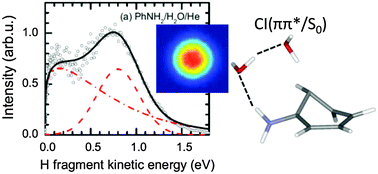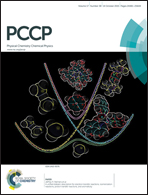Photodissociation of aniline N–H bonds in clusters of different nature†
Abstract
We investigated the solvent effects on the N–H bond photodisociation dynamics of aniline (PhNH2) in clusters using velocity map imaging (VMI). The VMI experiment was accompanied by a time-of-flight mass spectrometry after electron ionization to reveal the cluster nature. The H-fragment images were recorded at 243 nm in various expansion regimes corresponding to different species: isolated molecules; small (PhNH2)N, N ≤ 3, clusters; larger (PhNH2)N, N ≥ 10; small mixed PhNH2·(H2O)N, N ≤ 10, clusters; and individual PhNH2 molecules deposited on large (H2O)N, ![[N with combining macron]](https://www.rsc.org/images/entities/i_char_004e_0304.gif) = 430. The H-fragment kinetic energy distributions exhibit fast fragments around 0.8 eV (A) assigned previously to a direct dissociation along a repulsive πσ* state potential, and slow statistical fragments peaking near 0.2 eV (B). In the aniline clusters the contribution of fast fragments (A) decreases relatively to (B) with increasing cluster size. A similar effect is observed when aniline is solvated with water molecules. The experimental data are interpreted with ab initio calculations. Cluster structures were calculated with both N–H bonds of an aniline molecule participating in hydrogen bonding, as well as the ones with free N–H bonds. The latter ones yield preferentially the fast fragments as the isolated molecule. For N–H engaged in hydrogen bonding a barrier increased along the N–H coordinate on the dissociative πσ* state potential surface, and also the energy of πσ*/S0 conical intersection increased. Thus the fast dissociation channel was closed stabilizing the molecule in clusters. The population could be funnelled through other conical intersections into the hot ground state which decayed statistically, yielding the slow H-fragments.
= 430. The H-fragment kinetic energy distributions exhibit fast fragments around 0.8 eV (A) assigned previously to a direct dissociation along a repulsive πσ* state potential, and slow statistical fragments peaking near 0.2 eV (B). In the aniline clusters the contribution of fast fragments (A) decreases relatively to (B) with increasing cluster size. A similar effect is observed when aniline is solvated with water molecules. The experimental data are interpreted with ab initio calculations. Cluster structures were calculated with both N–H bonds of an aniline molecule participating in hydrogen bonding, as well as the ones with free N–H bonds. The latter ones yield preferentially the fast fragments as the isolated molecule. For N–H engaged in hydrogen bonding a barrier increased along the N–H coordinate on the dissociative πσ* state potential surface, and also the energy of πσ*/S0 conical intersection increased. Thus the fast dissociation channel was closed stabilizing the molecule in clusters. The population could be funnelled through other conical intersections into the hot ground state which decayed statistically, yielding the slow H-fragments.


 Please wait while we load your content...
Please wait while we load your content...